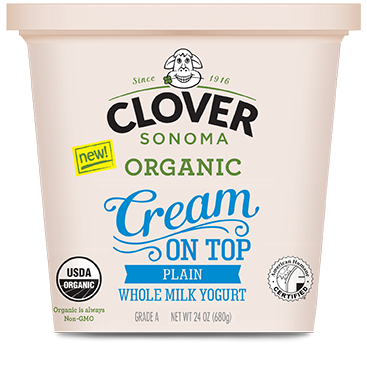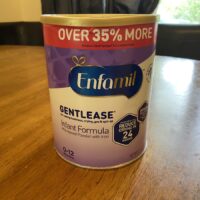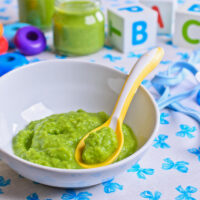This article explains how to choose the best yogurt for babies, and answers some of the most frequently asked questions. You’ll also find reviews of some of the best baby yogurt brands, and how to make a healthy, tasty treat for your little one!
Best Baby Yogurt
GoGo squeeZ yogurtZ is a great yogurt pouch option that can be tossed in a diaper bag for an “on the go” snack. Gerber Yogurt Melts are freeze-dried yogurt finger food melts for an older baby or toddler.
GoGo squeeZ YogurtZ
Three words: shelf-stable yogurt. Don’t be afraid! The GoGo squeeZ YogurtZ is still the healthy and tasty yogurt you’ve come to know and love, just in an unrefrigerated form. The retort sterilization process, developed in Normandy, France, provides a shelf-stable yogurt that’s totally safe to eat. So, while your baby may miss out on the live active cultures found in other yogurts, GoGo Squeez is still a high-protein snack, fortified with calcium and vitamin D.
This product is a great way to fill up tiny tummies with the creamy goodness of yogurt when you’re away from home. It’s also great for older siblings to share at school!
Siggi’s Yogurt
Siggi’s Yogurt is revered by adults for it’s deliciously creamy taste and texture. That’s because it’s a thick yogurt with added cream for a glorious texture. There are lots of flavors, but the best choice for a baby would be the whole milk versions. This additional fat is important for infant brain development (source). While lower in sugar than other yogurts on the market, there is a small amount of cane sugar added to the ones with fruit. Even if you opt for these, rest assured that the yogurt contains no aspartame, sucralose, or other artificial sweeteners. The one with added honey, however, should be avoided until age 12 months due to the risk of botulism (source).
The milk for Siggi’s yogurt is sourced from cows that are responsibly farmed in New York State and Wisconsin. They are never given any growth hormones. Each of these yogurts provide five live active cultures to help a baby’s gut health.
Gerber Yogurt Melts
Gerber Freeze-Dried Yogurt Melts quickly dissolve on your little one’s tongue. This makes them perfect for babies still learning to chew and swallow. They are fun finger foods that can help older infants practice their pincer grasp skills. Per the manufacturer’s recommendations, they should not be introduced prior to age eight months. Toddlers will love to eat these too!
Gerber Yogurt Melts are made without using preservatives or artificial sweeteners and flavors. Although “cultured” low fat milk is used in this product, there are no live active cultures because of the freeze-drying process. The shape of these puffs is easy for little fingers to pick up for self-feeding. Gerber yogurt melts are also a good source of vitamins A, C, and E.
Best Organic Baby Yogurt
Mama Bear Organic Baby Food comes in a 4 oz pouch with a resealable cap, while the Gerber Organic Yogurt is in 3.5 oz pouches, but includes a smart flow spout to control the speed at which your baby eats.
Stonyfield Farm Organic YoBaby
The best organic yogurt for your little one is Stonyfield Organic YoBaby Yogurt. Created with infant palates in mind, these whole milk yogurts contain live active cultures, and are available in a variety of flavors. You can also choose the YoBaby Plain, and mix in flavor combinations that your baby or toddler will love. These products are non-GMO, Kosher, and gluten-free.
Although it is intended for infants, one downside of this product is its large portion size. The 4-ounce container is too much for most babies to finish in one meal. Any remaining yogurt may be wrapped and refrigerated for later use.
Earth’s Best Organic Fruit Yogurt Smoothie
This is actually a product intended for toddlers. The pouch design of Earth’s Best Organic Fruit Yogurt Smoothie makes it easy to feed your little one. The smoothies are fruit purees blended with yogurt. Vitamins C and D are added. These smoothies contain non-GMO ingredients, and meet the criteria for organic and kosher certifications.
Another major benefit is that the pouches are resealable. This means no struggling with plastic wrap or a bag to refrigerate the uneaten portion. The packaging also features a cute Sesame-street-themed design.
Although organic cultured milk is used, there are no live active cultures in this yogurt.
Happy Baby Organic Yogis Freeze-Dried Snacks
The Happy Baby Organic Yogis Freeze-Dried Snacks are made with certified organic yogurt and fruit purees. They melt away in your little one’s mouth, and are the perfect size for grasping fingers. These snacks are designed for older babies and toddlers, at least 8 months of age, who can crawl without their belly touching the ground. Unlike other yogurt snacks, two probiotic strains are included.
Similar to Gerber’s yogurt snacks, they have added sugar. In addition, the size of the drops is larger than those of some other brands. They can also spoil if the bag is left open.
Mama Bear Organic Stage 2 Baby Food With Yogurt
Mama Bear Organic Stage 2 Baby Food is made without artificial flavors or colors, GMO ingredients, or added salt. Its only ingredients are organic yogurt, fruit purees, and added vitamin C to preserve color. Because the product is heat-treated, there are no live active cultures.
This brand’s stage 2 line is designed for babies 6 months and older. If an infant has been solely breastfed for the first six months of life, it is best to offer this blended food after single foods have been tried and tolerated (source). For infants who begin “first foods” at four months, it is ok to try offering this product at six months.
The cap on these pouches is resealable.
Gerber Purees Organic Yogurt Pouch
The Gerber Purees Organic Yogurt Pouch line has at least a dozen flavors for your little one to try. It is made with organic yogurt and fruit purees, and contains no artificial ingredients. This product is non-GMO, and features BPA-free packaging.
The Smart Flow spout is a nice feature. It controls the flow of the food so your baby doesn’t choke from eating too quickly.
Clover Organic Farms Cream on Top

Clover Organic Farms Cream on Top is another healthy option for babies.
This is an American Humane Certified option which is great for parents who are concerned about humane animal practices in the foods they purchase. The yogurt is produced at Clover Farms in northern California.
The plain yogurt is best for babies because it is sugar-free, but there are plenty of flavors that your toddler (and mom and dad) will love later on. The creamy texture of this yogurt makes it perfect for blending in smoothies or making homemade yogurt drops. These yogurts contain live active cultures.
Best Dairy-Free Yogurt for Babies
NurturMe Organic Dairy-Free Yogurt
For babies who don’t tolerate cow’s milk, NurturMe Organic Dairy-Free Yogurt is a good choice. This option is made using quinoa milk, pea protein, and coconut cream.
This yogurt is at the top of the list for mothers who are worried about food allergies. It is non-GMO, certified organic, gluten-free, vegan, and kosher. It is also free of any dairy, soy, or eggs. The plant proteins are broken down, making them easy for your little one to eat and digest.
How These Yogurt’s for Babies Compare
The table below compares only the recommended products on this page. A low or high Price means it is low or high compared to the other products listed. The Popularity Score reflects how often readers click on and buy the product. The Quality Score is our assessment of the overall performance and satisfaction with the product compared to others in the table.
| GoGo squeeZ YogurtZ | 3.9 | 9.4 | 52.74 |
| Gerber Purees Organic Yogurt Pouch | 5.6 | 9.4 | 23.88 |
| Gerber Yogurt Melts | 9.0 | 9.8 | 22.96 |
| Earth's Best Organic Fruit Yogurt Smoothie | 7.7 | 9.4 | 19.68 |
| Mama Bear Organic Stage 2 Baby Food With Yogurt | 8.9 | 9.2 | 16.90 |
| Happy Baby Organic Yogis Freeze-Dried Snacks | 9.9 | 9.4 | 7.83 |
| Stonyfield Farm Organic YoBaby | - | 9.6 | - |
| Siggi's Yogurt | - | 9.2 | - |
| NurturMe Organic Dairy-Free Yogurt | - | 8.4 | - |
Greek vs Regular Yogurt
If you’re wondering what the difference is between Greek and regular yogurt, here is a comparison:
| Greek Yogurt | Regular Yogurt |
| Thicker with a tangier taste | Less tangy taste and more fluid (easier to mix with things) |
| Strained: 3 times (results in less whey) | Strained: 2 times |
| More protein, fewer carbs | More carbs, less protein |
Calcium may be lost during the straining process of Greek yogurt (source). Some manufacturers add calcium to account for this, so be sure to check labels.
What to Look For
The best yogurts will offer high-quality nutrition that you can rely on. Here’s what you should look for, and what to avoid when choosing yogurt for your baby:
- Whole-Fat Yogurt. Adult yogurts are more commonly low-fat. However, kids under age two need more fat in their diets (source). Full-fat milk contains omega-3 fatty acids that are critical for healthy brain development.
- Organic. Even though pediatricians have mixed opinions on the nutritional benefits of organic foods, there is definitely a lower risk of pesticide exposure (source). Pesticides can cause health problems in children and adults, especially with repeated exposure. Organic milk is also sourced from cows that have not received hormone treatments or antibiotics. Despite safety statements issued by the FDA and USDA, some in the scientific community have concerns about the effects of these exposures (source).
- Live Active Cultures. Most refrigerated brands of yogurt contain live cultures. These are used to break down the milk protein and produce lactic acid which gives yogurt its sour’ taste (source). Some brands contain two strains, while others have up to six.
- Other Considerations. The unique fermentation process each yogurt undergoes affects the overall flavor and consistency. Some are thicker than others, especially full-fat baby yogurts. Don’t be afraid to try more than one brand if your little one doesn’t seem to like yogurt on the first attempt.
What to Avoid
- Sugar and Artificial Sweeteners. Infants don’t need added sugar in the foods they eat. Breast milk and fruits already have high levels of naturally-occurring sugar. Sugar is also added to infant formulas, usually to improve the taste. Introducing sugar during infancy can create a preference for sweet tastes, leading to increased sugar consumption as children and adults (source). Excessive dietary sugar can cause obesity and dental caries. Unfortunately, artificial sweeteners like aspartame, neotame, saccharin, and sucralose stimulate the same cravings for sweet tastes (source). Similar rates of cardiovascular disease, diabetes, weight gain, and obesity are seen when these sweeteners are used.
- Artificial Colors and Flavoring. While there are mixed opinions on artificial colors, some countries around the world have banned them (source). It is better to err on the side of caution, and keep them out of your little one’s food. Artificial flavorings should also be avoided.
Ideas for Flavoring Yogurt
Sometimes, plain yogurt isn’t acceptable for infant taste buds. Here are some ways to naturally flavor yogurt for your baby:
- Fruit and Veggie Purees. Basically any fruit or vegetable in a pureed form will mix well into yogurt such as berries, bananas, carrots, and more. Add a dash of cinnamon for an extra fun taste. This is a helpful way to incorporate more veggies into your baby’s diet too.
- Applesauce. Mixing applesauce into yogurt is a no-brainer! It’s easy to do, and pleasing to taste buds. You can easily prepare this mixture “on the go” by bringing along applesauce pouches.
- Nut Butter. After your baby is six months old, incorporating a bit of almond, peanut, or other nut butter into yogurt is a good way to add flavor and protein.
- Fruit-on-the-bottom. Making your own fruit-on-the-bottom yogurt is a fun way for older babies and toddlers to get excited about eating yogurt.
- Avocado. Say yes to healthy fats! Adding avocado to yogurt is a great way to flavor it, and incorporate a yummy healthy fat.
If you’d rather purchase a flavored yogurt instead of making your own, Gerber has a variety of yogurt blends that travel well.
Using Baby Yogurt to Make Tasty Treats
Pediatricians recommend introducing plain, whole milk yogurt first. This helps you assess for cow’s milk protein allergy or digestive problems. Most infants with this allergy, however, show symptoms within the first few months of life. After the first taste, there are plenty of healthy ways to make yogurt more palatable for your baby.
You should avoid artificially sweetened and flavored yogurts. Here are a few ideas of foods that can be stirred into your baby’s yogurt:
- Applesauce
- Sweet potato
- Mashed bananas
- Pureed pumpkin
- Pureed pears
- Mashed avocado
Yogurt can also be a useful tool once your little one starts teething. Fill an ice cube tray with yogurt and fruit puree made in a baby food maker, then freeze it. The cube then becomes the perfect teether to soothe sore, painful gums.
Something babies, however, don’t initially love cold foods. If yours does not, empty the yogurt into a bowl, and allow it to come to room temperature before feeding.
FAQs – Baby Yogurt
When can babies have yogurt?
During the first six months of life, babies receive full nutrition from breast milk or formula. Even so, many parents choose to introduce foods at four months old (source). Introducing food early gets your baby comfortable with new flavors. It is also a fun way to supplement their regimen of formula or breast milk, while providing the calories needed to grow (source).
The recommendations of pediatricians on when to introduce yogurt vary. Some suggest holding off until your baby is eight to 10 months old. Others encourage feeding your baby yogurt as early as six months of age. According to the American Academy of Pediatrics, cow’s milk should not replace breastmilk or formula until one year of age. However, yogurt and cheese are processed in a way that is easy for infants to digest.
This means you may start feeding your little one yogurt as soon as you begin solid foods, generally around six months of age.
What are the benefits of yogurt for babies?
Yogurt is a good source of protein and calcium for infants and toddlers. Be sure to choose one that is full-fat which is better for healthy brain development.
The other major benefit of yogurt for babies is the presence of live-active cultures. These cultures are probiotics, meaning they promote healthy bacteria in your little one’s digestive tract (source). Everyone has trillions of good bacteria in their gut called flora. These flora affect immunity, allergic responses, digestion, and other areas of health. By introducing probiotics early, you can be sure your baby is getting a jumpstart on health.
And, just in case baby doesn’t love yogurt or needs an extra immunity boost, try some of the best baby probiotics.
Is it safe to feed my baby regular yogurt?
It is not necessary to feed your baby yogurt that is marketed specifically for infants. However, manufacturers of baby-specific yogurts create full-fat versions, and omit artificial flavors and sugars. Many of these options are certified organic. While the AAP has mixed opinions on organic foods for babies, they have concluded that there is a lower risk of exposure to antibiotics and hormones (source).
Baby yogurts are often more conveniently packaged, including squeezable pouches, puffs, or drinkable ones for toddlers.
Can I feed my baby Greek yogurt?
The major difference between Greek and regular yogurt is the amount of processing. Many babies do not have a problem digesting Greek yogurt which has a higher casein content. However, other infants may have difficulty breaking down the proteins when they eat yogurt (source). This could cause problems like gas and constipation.
If you do want to try Greek yogurt, it is best to give plain whole-milk yogurt first because it does not contain added sugar.
Is yogurt good for babies?
Yes! A full-fat yogurt without artificial sweeteners and little to no sugar is healthy food for your baby. It’s also best to introduce plain yogurt first, then flavored options, one at a time, in order to identify any possible allergens.
Can a 1-year-old eat low-fat yogurt?
In general, no. While one serving of low-fat yogurt is not harmful and is fine in a pinch, infants and toddlers should not consume low-fat or non-fat dairy products before age two.
How much yogurt can a baby eat?
An 8 to 12 month old baby probably should eat no more than two to four ounces of yogurt per day. A toddler can eat more, but it is important to be mindful of other dairy intake. Too much milk, yogurt, and cheese each day can lead to iron deficiency anemia and constipation (source).
Can babies have probiotic yogurt?
Yes. Probiotics have definite health advantages, aiding in digestion and boosting the immune system. Some of the baby yogurts on our list contain live active cultures.
What about snacks, including yogurt ones?
For babies seven to 12 months old, snacks should melt easily on the tongue. This prevents choking. The yogurt puffs and snacks on this list are designed to be safe, and also teach your baby to finger feed. These prepackaged snacks should be labeled as to which age the snack can be given.
As for other types of snacks, whole wheat “O’s” cereal, or soft cubes of cooked green beans, sweet potatoes, or butternut squash are great snacks. Small pieces of pears, melon, cheese, cubed bananas, or avocado are healthy, age appropriate snacks.















